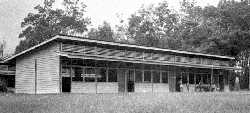Kampong Stenggang
History of St Theresa School, Kampong Stenggang
This is the transcript on an interview held on the 26 Dec 1998 with Nyapeng Pa Jisam, then then Tua Kampong.
TK: for Tua kampong, KA: for Kron Aken.


KA: How did the school came to the village?
TK: The history of the kampong school came with Noyeg Pa Jikem. He made friends with the Chinese while he was working for them. He had some schooling in those days following some Malays attending high school or sekolah dewasa. It was before the Japanese Occupation when he got his education, because during the Japanese Occupation he worked as a clerk for the Japanese. The Japanese were asking for contribution of padi from all the villages in Bau. Pa Jikem was asked to record the contributions from each village. This was the time when the Japanese supply ship was sunk at sea.
After the Japanese occupation, peace was restored. Pa Jikem returned to the kampong and started his own business selling salt, belachan, cigarettes and tobacco. He knew arithmetic. He said that if you can have an education like the Malays and Chinese, you can do very well in business. He asked for village meetings be held to see who can help build a village school. So several meetings were held. Around that time there was a European priest (Father Jackson) from Bau and he like to travel to the villages. The priest heard about the request for a kampong school and he visited our village. Even though he was a Catholic priest, the kampong held a Gawai to welcome him and to obtain his spiritual powers. The priest was not at all concern by the ritual because the people were not Christians. The Gawai for the priest was to ask for deliverance for abundant fruits, good rice harvest and healthy children. At the meeting the priest said that if the village can provide the land and built the school, he could help find the teachers and pay their salary. He said that through gotong-royong the villagers should level the ground for the school building. This was in 1952-53. So people then through gotong-royong leveled the ground. I also helped with the leveling. In 1953-54, the school was opened.
KA: Whose land was given for the school?
TK: It was Pa Jikem's land. This land is jointly-owned with my family, just like the land that is used for the Dewan Sekolah now. Pa Jikem really was a very good and generous person. He gave his land for the school without any payment. Because of Pa Jikem, people were able to build the school. The founding school committee were Pa Midel, Pa Jimis, Pa Somep. After that the next committee members were Pa Jiri, Pa Daon, Pa Sanen and Pa Nojem. The school was made of attap. People were giving their wholehearted support to the school to ensure its success. As years passed on, the road from Bau was coming closer and closer to the kampong. This was in the 1960's. In 1966, I had just got married and became a father (milah), people elected me to be the Chairman of the school committee. I was the school chairman for six years. There were a number of the old folks who criticised me. That said that I was a traitor and I was still practising the old adat and yet support the Mission school. They said that the Mission school would bring the downfall of the old adat of our forefathers. However, I did not care, for I was following the vision of Pa Jikem. You see Pa Jikem also followed the old adat and at the same time he was a keen supporter of the school. The first job that I undertook as a Chairman was the construction of a bridge near to the school [across Sungei Pidaram]. We were salvaging the belian posts that had been left by JKR after they had finished construction the bridge at the entrance to the kampong. There were six pieces of belian posts that were salvaged and dragged out. There was no help from the government only from the Mission. The priest gave us plan for the school building and we had to gotong-royong to get the timber sawn (pala tiang, kosu and leng) from the nearby mountains. All the timber materials were hand sawn. There were no chainsaws in those days. The villager sawyers and carpenters in those days were Pa Nayow, Pa Nogiem, Pa Jingen, Pa Junus, Pa Jimis and myself, even though I was still learning about the work.
KA: Was that the old school building or the current school building?
TK: It is the current school building. The old school building was built through gotong-royong when Pa Jikem was still alive. So eventually, the building for the current two school blocks were completed. As I was the Chairman of the school committee for six years, I wrote a letter saying that I want to step down. The new school committee members that took over were Pa Midiem, Pa Jingel and Pa Bino. So this is the story of the school.